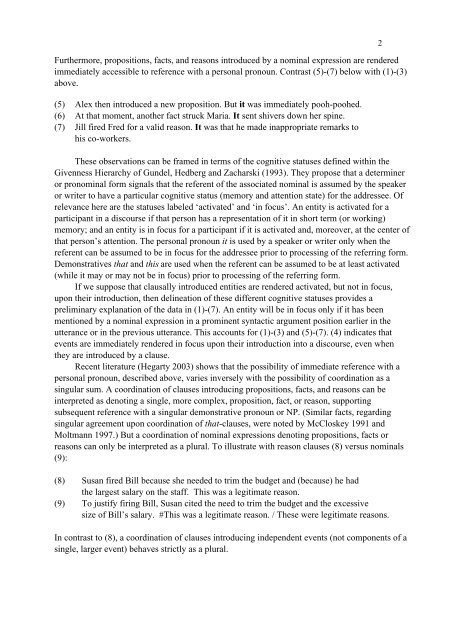SemPrag03.Progr.pdf - Institut für Linguistik/Germanistik - Universität ...
SemPrag03.Progr.pdf - Institut für Linguistik/Germanistik - Universität ...
SemPrag03.Progr.pdf - Institut für Linguistik/Germanistik - Universität ...
Create successful ePaper yourself
Turn your PDF publications into a flip-book with our unique Google optimized e-Paper software.
Furthermore, propositions, facts, and reasons introduced by a nominal expression are rendered<br />
immediately accessible to reference with a personal pronoun. Contrast (5)-(7) below with (1)-(3)<br />
above.<br />
(5) Alex then introduced a new proposition. But it was immediately pooh-poohed.<br />
(6) At that moment, another fact struck Maria. It sent shivers down her spine.<br />
(7) Jill fired Fred for a valid reason. It was that he made inappropriate remarks to<br />
his co-workers.<br />
These observations can be framed in terms of the cognitive statuses defined within the<br />
Givenness Hierarchy of Gundel, Hedberg and Zacharski (1993). They propose that a determiner<br />
or pronominal form signals that the referent of the associated nominal is assumed by the speaker<br />
or writer to have a particular cognitive status (memory and attention state) for the addressee. Of<br />
relevance here are the statuses labeled ‘activated’ and ‘in focus’. An entity is activated for a<br />
participant in a discourse if that person has a representation of it in short term (or working)<br />
memory; and an entity is in focus for a participant if it is activated and, moreover, at the center of<br />
that person’s attention. The personal pronoun it is used by a speaker or writer only when the<br />
referent can be assumed to be in focus for the addressee prior to processing of the referring form.<br />
Demonstratives that and this are used when the referent can be assumed to be at least activated<br />
(while it may or may not be in focus) prior to processing of the referring form.<br />
If we suppose that clausally introduced entities are rendered activated, but not in focus,<br />
upon their introduction, then delineation of these different cognitive statuses provides a<br />
preliminary explanation of the data in (1)-(7). An entity will be in focus only if it has been<br />
mentioned by a nominal expression in a prominent syntactic argument position earlier in the<br />
utterance or in the previous utterance. This accounts for (1)-(3) and (5)-(7). (4) indicates that<br />
events are immediately rendered in focus upon their introduction into a discourse, even when<br />
they are introduced by a clause.<br />
Recent literature (Hegarty 2003) shows that the possibility of immediate reference with a<br />
personal pronoun, described above, varies inversely with the possibility of coordination as a<br />
singular sum. A coordination of clauses introducing propositions, facts, and reasons can be<br />
interpreted as denoting a single, more complex, proposition, fact, or reason, supporting<br />
subsequent reference with a singular demonstrative pronoun or NP. (Similar facts, regarding<br />
singular agreement upon coordination of that-clauses, were noted by McCloskey 1991 and<br />
Moltmann 1997.) But a coordination of nominal expressions denoting propositions, facts or<br />
reasons can only be interpreted as a plural. To illustrate with reason clauses (8) versus nominals<br />
(9):<br />
(8) Susan fired Bill because she needed to trim the budget and (because) he had<br />
the largest salary on the staff. This was a legitimate reason.<br />
(9) To justify firing Bill, Susan cited the need to trim the budget and the excessive<br />
size of Bill’s salary. #This was a legitimate reason. / These were legitimate reasons.<br />
In contrast to (8), a coordination of clauses introducing independent events (not components of a<br />
single, larger event) behaves strictly as a plural.<br />
2

















